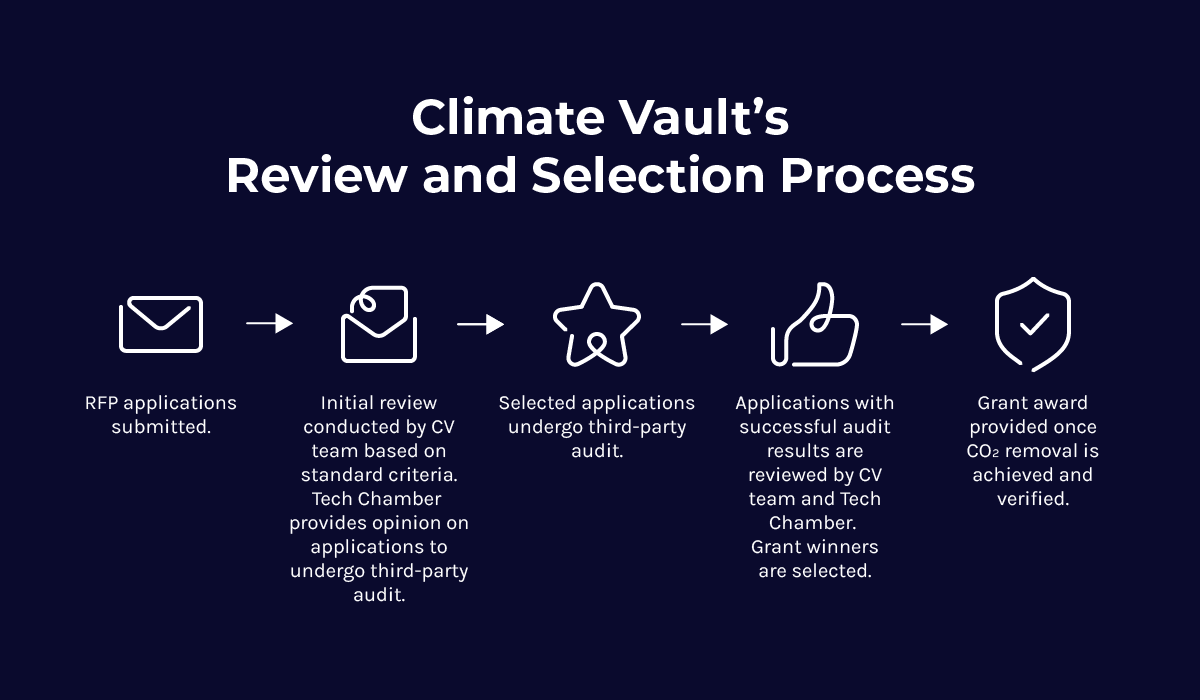Unlocking Innovation: Inside Climate Vault’s RFP Selection Process for CDR Projects
The carbon dioxide removal (CDR) space is dynamic and rapidly evolving. The past year has seen the development of promising technologies, new start-ups entering the market, notable offtake and pre-purchase agreements being made, and a portion of carbon removals being achieved and delivered. On top of all this, there are preliminary CDR project development and assessment guidelines being developed, government funding programs underway, and regional, federal and international dialogues in progress that will shape policies for guiding and supporting the continued growth of the CDR space.
Navigating the Evolving CDR Space
If you’re new to the carbon removal space, or want to find the most impactful way to support the growth of this critical emerging industry, it can be difficult to know where to start. You may be wondering: What carbon removal approaches are most effective at sequestering carbon? How do you know whether a CDR technology is credible and scalable? And what are the most important criteria that should be used to assess various CDR technologies?
At Climate Vault, we work with a world-renowned group of scientific experts to take the guesswork out of this process. Through our two-step, market-based approach to reducing and removing carbon, we enable our customers to achieve immediate climate impact, while also supporting the growth and scaling of the CDR market. Every emission allowance that we purchase and “vault” from the compliance carbon markets will ultimately be converted into an equal or greater number of carbon removals from rigorously vetted innovative CDR technologies.
These carbon removal technologies are identified through our annual RFP process, which is led by Climate Vault’s esteemed Technology Experts Chamber (“Tech Chamber”). With the intricacies in the CDR space, a meticulous vetting process by experts is imperative for securing the most promising and impactful CDR solutions. As Climate Vault wraps up our second-annual RFP process, we want to take a moment to detail our rigorous, step-by-step CDR technology evaluation process, and how we can help you navigate the complexity.
Climate Vault’s Rigorous CDR Evaluation Process
Climate Vault conducts a thorough 4-part analysis of each application that is submitted for its RFP program:
- Initial Review: Climate Vault conducts an initial review of all applications received during the open application submission period. The goal of the review is three-fold: 1) to verify that the proposed project is an eligible carbon removal solution*; 2) to confirm that the project meets Climate Vault’s and the Tech Chamber’s minimum permanence standards; and 3) to clarify any aspects of the application and supporting materials. Projects that meet these criteria then move forward to the second step of the review process..
*Note: Climate Vault currently does not accept afforestation, reforestation or similar forestry-related projects due to concerns about permanence. We also do not accept carbon capture and storage, or “CCS” projects, as these projects capture emissions from point sources of pollution, not from the atmosphere.
- Tech Chamber Assessment: Climate Vault’s Tech Chamber is chaired by former US Energy Secretary Ernest Moniz and features a group of world-renowned science and policy experts from Harvard, MIT, Princeton, and UC San Diego (Scripps). The Tech Chamber’s expansive knowledge base ensures that each project is assessed from multiple diverse perspectives. Based on their rigorous analysis, the Tech Chamber selects a subset of applicants to move forward to the next stage of Climate Vault’s assessment process—an independent audit. Between the two RFP cycles conducted to date, fewer than 17% of applicants have been selected by the Tech Chamber to move forward to audit.
- Independent Audit: Selected applicants undergo an independent assessment conducted by one of Climate Vault’s esteemed auditors, DNV and EnergyLink Services. The purpose of the audit is to: 1) confirm that the information presented in the applicants’ application materials is fair, accurate and complete; 2) maintain impartiality in Climate Vault’s selection process; and 3) provide the Tech Chamber with an additional data point to make their final decision regarding the outcome for the RFP process. After conducting their technical analysis and reviewing the independent audit reports, the Tech Chamber makes a final decision regarding the outcome for the RFP process, determining whether or not there will be winners.
- Independent Verification: Once a winner is identified, Climate Vault will enter into an “offtake agreement,” meaning that an award is only provided upon delivery of the carbon removals. However, Climate Vault takes things one step further by requiring the removals to be independently verified by our auditors. This provides an additional layer of assurance to our process and for our donor customers, to ensure each emission allowance is converted into at least one tonne of atmospheric carbon removals or more.
Image 1. Climate Vault’s RFP application review and selection process.

Cutting Through the Complexity
Through our comprehensive RFP process, Climate Vault cuts through the complexity of the CDR space to identify the most impactful carbon removal solutions on behalf of our customers. We reduce your administrative burden for sourcing and securing the highest quality and impactful CDR credits. Through our process, we seek to build a large, diverse portfolio of innovative, scalable carbon removal solutions—across project types and pathways—which can meet the challenge of the climate crisis.
To learn more about how you can verifiably knock out your carbon footprint by leveraging immediate carbon reductions into long-term carbon removals, reach out to the team here at Climate Vault.
